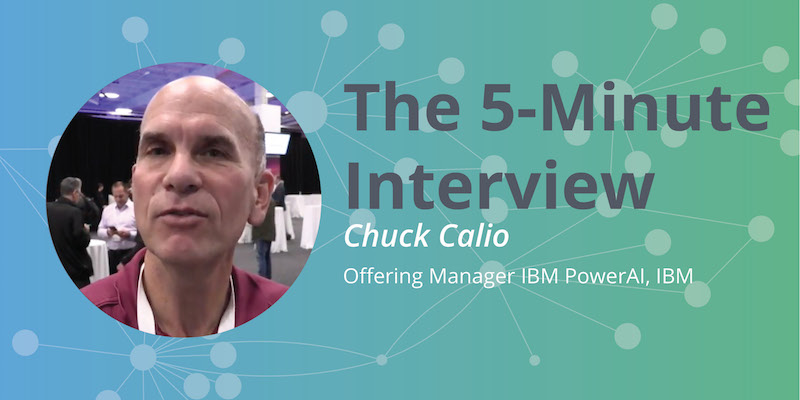Chip Design on Graphs: 5-Minute Interview with Chuck Calio, Offering Manager, IBM PowerAI

Editor-in-Chief, Neo4j
4 min read

We use Neo4j to design our next-generation Power chips, said Chuck Calio, Offering Manager IBM PowerAI at IBM.
The future of graph technology is in AI, but it’s not the only use case. From designing hardware (naturally a graph) to dynamic pricing, IBM’s Chuck Calio sees use cases for graphs as myriad and the demand from customers strong.
In this week’s five-minute interview (conducted at GraphTour San Francisco) we discuss how IBM designs next generation chips using Neo4j – and the way those chips accelerate graph algorithms.
Tell us about how you use Neo4j at IBM.
Chuck Calio: We started working with the Neo4j graph database as one of the four NoSQL database categories that we got into as a modern data platform for our customers who want NoSQL databases. But we’re quite pleased, over time, to see the evolution of Neo4j on Linux on Power.
Calio: We actually now use Neo4j to design our next-generation Power hardware, and then we run Neo4j on our hardware, and we use those results to re-optimize Neo4j. And now we have acceleration technology for Neo4j on Linux on Power that will optimize graph algorithms. So we’re super excited about that as one of the next steps in this relationship.
How do you use Neo4j in chip design?
Calio: We use Neo4j to design the chips that go into POWER9, and also our System z. So chips are really gate logics, switching logics, and at the end of the day, if you conceptualize that, it’s a graph. It’s a path forward through logic.
Previously, we used relational database technology. It was really slow – it took too long to change. Now we use graph technology from Neo4j.
We used Neo4j software to design the next generation chips. Then we ran Neo4j on that hardware, and we were able to do some traces and identify areas where we could redesign and optimize Neo4j.
And then, in this new field in hardware called acceleration, which we’re all very interested in, we have the ability to use our Coherent Accelerator Processor Interface (CAPI) to accelerate Neo4j graph algorithms, which is the next growth area, as far as we’re concerned.
How is your partnership with Neo4j going?
Calio: We have a running joke that IBM and Neo4j are recursive – we keep calling each other. I’ve managed a lot of vendor relationships in my role at IBM. Neo4j is a great partner and they have a lot of good products. There’s a really high-level of client interest in graph in general, and Neo4j is the number one graph provider. That’s why we’re really close with Neo4j.
In terms of our engineering partnership, Neo4j is really strong to work with. We have a good executive partnership. Across the board, it’s a very good partnership.
Where do you find graphs especially compelling?
Calio: In terms of graph in general, it’s a very high-growth solution by itself. But also, at IBM, we’re interested in cognitive and AI, and one of the linkages that we see in the future is the linkage between Neo4j graph and cognitive AI solutions, machine learning, deep learning, and those kinds of things. So we have a big vision of the future of both high-value solutions running well together and optimized deeply. A very bright future for both companies.
What do you think the future of graph technology looks like?
Calio: I think the future of graph will be more with AI. That’s my opinion. I see the use of graph to feed artificial intelligence, machine learning and deep learning. In many cases, feature extraction, for example, is difficult to do, especially with large datasets.
There are many other use cases for graph, though. Graph is leading-edge technology for cybersecurity. Clearly, graph is excellent for master data management across the board, not just in the scenario of AI, is important. Recommendation engines are also important to have. An area I’m fascinated with is dynamic pricing, and how we can use graph technology to do that. I think that that’s really one of the things that could fundamentally change the business. I think dynamic pricing is a really exciting use case.
Anything else you’d like to add?
Calio: Neo4j’s a great company to partner with. From an IBM standpoint, I’d like to thank Neo4j for being such a great partner, and I know that the future is going to be really high growth, and it’s very important for Neo4j to be out there across the globe with the high-value solutions that they provide.
Want to share about your Neo4j project in a future 5-Minute Interview? Drop us a line at content@neo4j.com
Take a closer look into the powerhouse behind the analysis of real-world networks: graph algorithms. Read this white paper – Optimized Graph Algorithms in Neo4j – and learn how to harness graph algorithms to tackle your toughest connected data challenge.








